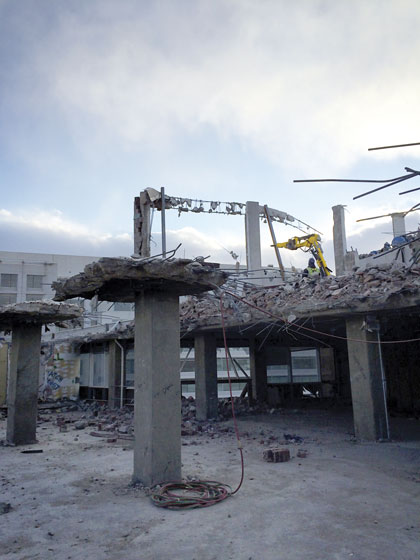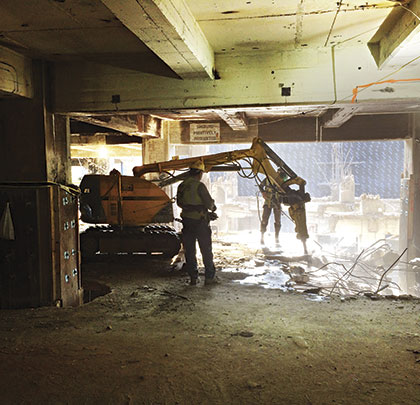When it comes to handling high-profile projects, Baltimore-based demolition contracting firm, The Berg Corporation, wrote the book. In this case, their task will center around one of the biggest, most widely read books of all time—the much-publicized up-and-coming Museum of the Bible.
The Museum of the Bible, an $800 million endeavor funded primarily by Hobby Lobby’s president Steve Green, will open to the public in fall 2017. It will sit approximately two blocks from the National Mall. The efforts to turn a 1920s refrigeration warehouse and neighboring buildings into the 430,000-square-foot display case for Green’s trove of nearly 44,000 Biblical pieces will take time—and some heavy-hitting power early on.
Following months of study and collaboration between Berg Corporation and Clark Construction, the project started. Clark managed the pre-construction contingent and Terence Anderson, vice president of estimating for Berg Corporation, helped take it from there.
The team’s delicate but aggressive mission? Take out every other floor of the Washington Design Center, add 5 more feet of depth to the basement and remove the roof. Demolish the 1982, 50,000-square-foot Hyphen Building, sandwiched between the Washington Design Center and Washington Office Center. The Washington Office Center also demanded extensive structural work on the underground parking area and foundation walls. The plan included on-site and remote processing and sorting, resulting in over 90 percent of the building contents, by weight, being recycled.
PICK AND CHOOSE
The way Berg’s management team saw it, there were two ways to tackle the project: They could use skid-steer loaders with hammer attachments along with operators on handheld jackhammers and rivet busters, or they could bring in lightweight, remote-controlled demolition equipment to do the heavy hitting, as well as small skid-steer loaders to quickly remove the debris.
The first option carried the risk of exposing employees to ongoing fall hazards and poor air quality and exaggerated labor costs. The use of remote-controlled demolition equipment would greatly reduce fall hazard exposure, improve air quality, dramatically decrease labor costs, and bring the schedule into line with the opening of the museum. Berg chose the remote-controlled Brokk demolition machines for the bulk of the selective building demolition. The machines can be equipped with numerous attachments, from breakers and steel cutters to buckets and drills.
“The floor load would not allow mini-excavators, so this was really a problem that could only be solved by a Brokk robotic demolition machine,” says Christopher Trendell, vice president of operations at The Berg Corporation. “There is a dramatic amount of variance in the construction of both buildings, and both of them are extremely light loading capacity. The Brokks offered the heavy hitting power on a light-weight carriage. It was by far the most productive, cost-effective solution.”

The Berg team used both Atlas Copco breakers and Darda concrete cutters on the Brokk machines’ arms, which they maneuvered with wireless remote control as they demolished their way through 5,000-square-foot sections.
OFF COMES THE ROOF
First, the team gutted the warehouse and Hyphen Office Building. Steel bracing plates, tubular steel, and steel rakers were then installed at perimeter and interior columns to shore the Washington Design Center. Then, they were ready to tear the roof off—literally—since the height of the main, 310,000-square-foot warehouse will be increased. From there, they worked their way down the eight-story building, demolishing every other floor to give the museum more open space than the existing 12-foot-high ceilings allowed.
A crane lifted tracked Brokk 260’s and 160’s robotic demolition machines and skid-steer loaders to the eighth floor to begin the project. The Berg team used both Atlas Copco breakers and Darda concrete cutters on the Brokk machines’ arms, which they maneuvered with wireless remote control as they demolished their way through 5,000-square-foot sections. Skid-steer loaders quickly pushed the debris down a chute to minimize the weight on the disappearing floor. Then, the machines shifted to the sixth floor, tackling the columns and beams first. They saw-cut slots on the opposite sides of each interior column, added steel bracing, and then repeated the process on the other sides so the columns could be freestanding. That process repeated on each even-numbered floor, covering 65 interior columns spanning anywhere from 2.25 square feet to 9 square feet. Once they braced the columns and shored the floor, it was back to demolishing the reinforced 8- to 10-inch-thick concrete floors.
DONE BUT WAITING
In less than 4 months, The Berg Corporation completed the multifaceted project, from the precarious demolition of every other warehouse floor and the neighboring Hyphen Building to the hard-hitting removal of the warehouse roof and gutting the basement, all while recycling a massive amount of rebar and concrete. Plus, Trendell says, “The Brokks’ straightforward preventive maintenance was integral to keeping our fleet operational and ensured no downtime.”
Now that he knows he picked the right tool option, he and his team will need to be patient to see the final culmination of their work. Once all is said and done, the old train loading dock on 4th Street Southwest will shine as the museum’s main entrance, flanked with tall bronze panels and a 40-foot-high stained glass piece. Once inside, visitors will enjoy the rooftop ballroom and auditorium, dine on Biblical-themed meals in an on-site restaurant or walk through a child-focused Noah’s Ark experience filled with videos and holograms. The floors that Berg’s team moved Brokk machines and skid-steers across will display one of the world’s largest collections of Torah scrolls and fragments of the Dead Sea Scrolls. Bibles of the distant and recent past also will be on display, from a portion of the Gutenberg Bible to Bibles used by Babe Ruth and Elvis Presley.
Museum visitors likely will ponder the artifacts more than the building and how it came to be, but The Berg Corporation can take pride in knowing this project is another one for the books. ■
For More Information: For more information about Brokk’s robotic demolition machines, visit www.brokk.com.
_________________________________________________________________________
Modern Contractor Solutions – August 2016
Did you enjoy this article?
Subscribe to the FREE Digital Edition of Modern Contractor Solutions magazine.

Leap of Faith


